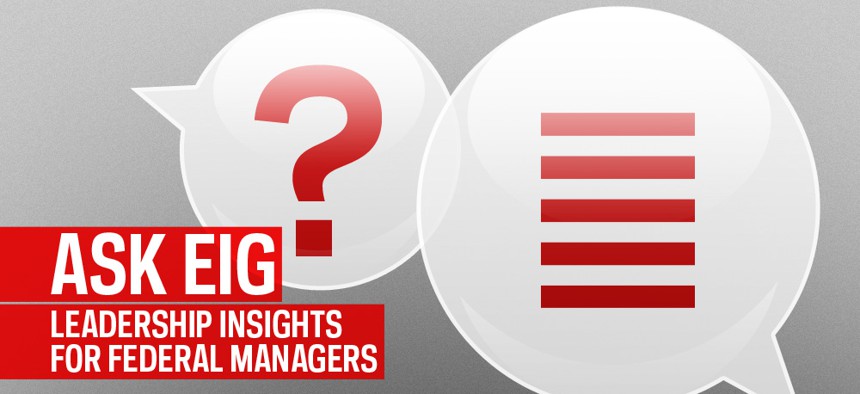Without Financial Incentives, How Can I Encourage Innovation?
Managers must understand the trade offs that stand in the way of federal innovation.
To begin my column, I want to thank you all for sending in questions. Your questions are interesting, challenging, and a great source of learning for me and, I hope, for those who read my responses. I do have a backlog so I apologize that it may take me a while to get to all of your questions. Nonetheless, please keep your questions coming and I will do my best to respond to them.
As a senior leader in the current Federal Government environment where agencies are struggling with increasing mission requirements, severe resource constraints, major limitations to our ability to compensate and reward employees, and cynicism by the workforce for new management initiatives, how do I sustain my employees' motivation and enthusiasm to not only perform successfully but to also innovate?
--Anonymous
Innovation offers an intriguing and great path to work an organization’s way out of difficult economic times. Expressions like “doing more with less” or “doing the same with much less” signify that coming up with innovative processes and products are necessary to continue to deliver existing (and perhaps some new) government services but at a lower cost.
Yet, it is precisely during difficult economic times that budgets are cut back. During such times, it should be expected that agencies, their leaders, and Congress adopt a vigilant focus on issues of accountability, performance measurement, ferreting out waste and fraud and reducing costs. This top-down cost-focus creates fear, uncertainty, and, ultimately, inertia among employees, which greatly undermines employee willingness to innovate. How, in this cost conscience environment, can an agency leader sustain employee motivation, perform successfully and innovate?
In many ways, your idea to focus on innovation is a good one. Innovating creates opportunities for people to learn. Developing something new and seeing it create value for others can be very motivating. Indeed, in difficult economic times, engaging in innovation seems like a silver bullet that can motivate employees and generate superior performance all at the same time. Within this view, the real question becomes how, as a leader, can you encourage your employees to innovate in such an environment?
What may initially seem like a good idea—stimulating your employees to innovate—ultimately confronts the immutable fact that organizational systems involve trade-offs. A centralized organization cannot act like a decentralized organization and vice-versa. A compliance-based organization cannot act like a commitment-based organization and vice-versa. And, an organization focusing on cost controls cannot excel at innovation and vice-versa.
Designing an organization involves a multitude of decisions around compensation, job design, metrics and measurement, decision rights, hiring and firing, career advancement, training, managing conflict, communications, and culture. These decisions are not independent of each other; well-designed organizations account for how a decision on one dimension connects to decisions on the other dimensions. Only when the set of decisions compliment each other can an organization achieve high performance.
Please note that “performance” is in the eyes of the organizational designer. A well-designed high-accountability organization can perform well at being accountable. A well-designed innovative organization can perform well at being innovative. But achieving high levels of performance on both of these dimensions at the same time—the desire of almost every organizational leader—is difficult if not impossible.
Put differently, all organizational designs involve tradeoffs that yield the profound implication that a single organization cannot accomplish all goals equally well, at least not at the same time. So don’t expect high levels of innovation when your current organizational design and environment are focused on cost containment.
So what is a leader to do? Is innovation impossible during an age of austerity? I believe that with the appropriate leadership, you and your employees can innovate, at least a little. The key to innovating in such an environment is that you, as the leader, must lead the innovation effort.
In the current atmosphere, employees will not innovate on their own, even if you ask them to. Delegating innovation is not feasible because the organizational design and culture is encouraging them not to innovate. But, if you lead the innovation team, your employees are more likely to participate and try to innovate. With you leading the team, they have the opportunity to get your attention, to learn from you, and to understand what you think is important. Your time is valuable to them. They also will understand that, as the leader of the innovation team, you will provide protection from bad things happening to them if the innovation does not go well. Your leadership can make the difference.
The downside of you leading the innovation team is that we all have a finite amount of time and attention. If you lead the team, you have to make trade-offs and let something go or slide. In essence, when you cannot delegate to others, your time and attention become the innovation bottleneck.
Innovating within the government context during the age of austerity is more than difficult. Pressures from accountability, performance measurement, ferreting out waste and fraud, and reducing costs all work against taking the risks needed for innovation. Therefore, leaders should not expect much innovation from their workforce unless they lead the innovation effort themselves. I encourage you to lead your innovation team but also to recognize what trade-offs you are making by doing so.
Duce a mente (May you lead by thinking),
Jackson Nickerson








